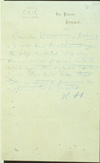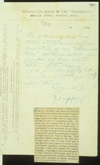Mahatma Letter No. 109
| Quick Facts | |
|---|---|
| People involved | |
| Written by: | Koot Hoomi |
| Received by: | Damodar or H. P. Blavatsky |
| Sent via: | unknown |
| Dates | |
| Written on: | unknown |
| Received on: | probably March 1883 - see below |
| Other dates: | unknown |
| Places | |
| Sent from: | unknown |
| Received at: | probably Madras, India |
| Via: | unknown |
This is Letter No. 109 in The Mahatma Letters to A. P. Sinnett, 4th chronological edition. It corresponds to Letter No. 119 in Barker numbering. See below for Context and background.
< Prev letter chrono
Next letter chrono >
< Prev letter Barker
Next letter Barker >
Page 1 transcription, image, and notes
|
Give Mr. Sinnett my salams — and ask him to comment upon the slip enclosed. He may know what I mean him to write upon the subject editorially. Tell him also that time is short and precious and ought not to be wasted. |
NOTES:
|
Page 2
|
The following may lead later on to a curious confirmation of our "obscuration" doctrine which so puzzles my friend — the Editor of the "Phoenix". Will you kindly and likewise, comment upon it and oblige thereby, Yours, NEWSPAPER CUTTING Sir John Lubbock's opinion confirms or endorses the conclusion long since put forth by some of the most eminent astronomers, namely, that there are now in the solar system, or firmament, many dark bodies — that is, bodies which now emit no light, or comparatively little. He points out, for example, that in the case of Procyon the existence of an invisible body is demonstrated by the movement of the visible stars. Another illustration which he cites relates to the notable phenomena presented by Algow, the bright star in the Head of Medusa. This star shines without change for two days and thirteen hours; then, in three hours and a half, dwindles from a star of the second to one of the fourth magnitude; and then, in another three and a half hours, resumes its original brilliancy. According to the view entertained by Professor Lubbock, these changes must be regarded as indicating the presence of an opaque body, which intercepts at regular intervals a part of the light emitted by Algow. |
|
NOTES: |
Context and background
The person to whom this letter (or, rather, two short notes and a news clipping) is addressed is not indicated, although it may have been [[H. P. Blavatsky, [[Damodar K. Mavalankar], or H. S. Olcott, since the Mahatma seems occasionally to have sent messages through all these persons. The two notes are for the purpose of transmitting a newspaper clipping and suggesting that it be given to A. P. Sinnett.
Sir John Lubbock, mentioned in the clipping, lived 1834-1913. He was an English banker and naturalist. He was the first to use the terms Paleolithic and Neolithic Age. Procyon is a bright star in the constellation Canis (the Lesser Dog) east of Orion, near Gemini. Algoe (Algol) is a bright variable star in Perseus. It loses most of its brightness when eclipsed by its dark companion. In Greek mythology, Medusa was one of the three Gorgons slain by Perseus.
Physical description of letter
The original is in the British Library, Folio 3. George Linton and Virginia Hanson described the letter this way:
KH script in blue pencil on a sheet of Pioneer letterhead, paper size 5" X 8" [12.7 X 20.3 cm]. The addressee in not indicated but may have been HPB or Damodar. The second note signed by KH is in blue pencil on a sheet of paper bearing the letterhead of "publication office,The Theosophist,Beach Kandy, Bombay, India." It is presumably addressed to APS.
A newspaper clipping is pasted on the same sheet of paper, beneath the note.[1]
Publication history
Commentary about this letter
Notes
- ↑ George E. Linton and Virginia Hanson, eds., Readers Guide to The Mahatma Letters to A. P. Sinnett (Adyar, Chennai, India: Theosophical Publishing House, 1972), 176.

